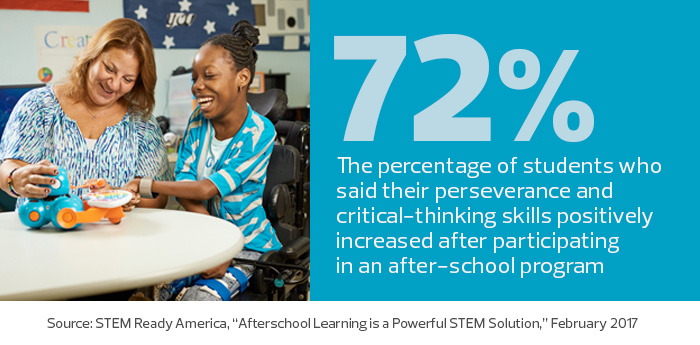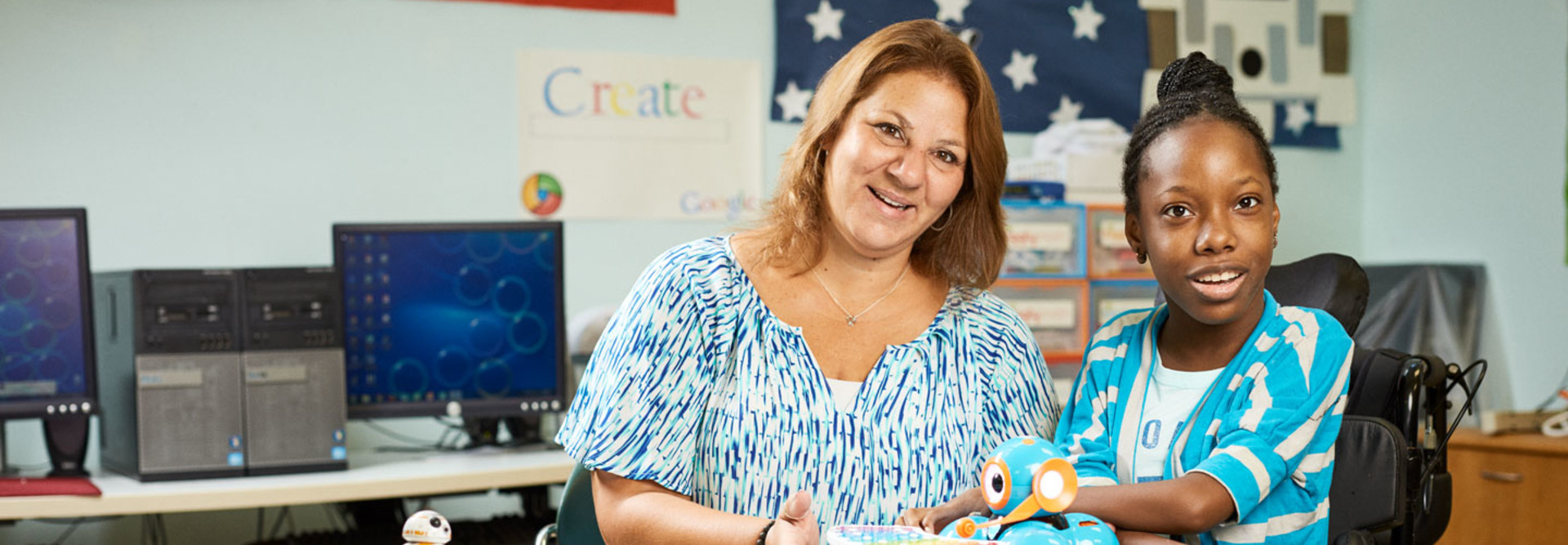How Tech Can Help Students with Disabilities Thrive in STEM Education
When Stephanie Talalai began as the technology coordinator at A. Harry Moore School 26 years ago, nonverbal students communicated using pieces of paper with “yes” and “no” on them. Today, students can control computers using their eyes.
“In terms of providing access,” Talalai says, “the technology has come a long way.” For students with disabilities, tech tools can help provide new and engaging ways to access content in science, technology, engineering and math.
EdTech asked educators to share tips about how to use technology to give students with special needs the same access to STEM activities as other schoolchildren. Here are their recommendations.
SIGN UP: Get more news from the EdTech newsletter in your inbox every two weeks!
Differentiate Instruction to Support All Students
Many students at A. Harry Moore in Jersey City, N.J., have disabilities that limit their cognitive development, but Talalai says teachers there find ways to incorporate tools such as drones and 3D printers.
“We try to give them the same experience they would have in a typical school,” she says. “They can control a robot through a tablet and move it around the room.” Other students can participate in basic coding lessons, Talalai says.
“Anything can be adapted for students with disabilities,” she says. “It’s just a matter of what accommodation you are going to give them.” In coding classes, they might need more time than other students, she says. “They need someone to sit down next to them.”
For some students, just knowing where to start can be a challenge. Luis Perez, an independent education consultant who specializes in universal design for learning and assistive technology, recommends that science teachers create short video clips to help remind students of lab procedures.
The solution can help all students and doesn’t draw attention to those with special needs, Perez says. Students can then watch the clips on their mobile devices using QR codes.

“If you need it, you use it. If you don’t need it, you ignore it,” says Perez, whose passion for special education is fueled in part by his experience as a student with a visual impairment. “Assistive technology had a big stigma, and that’s why I didn’t use it, even though I needed it,” he adds. “As IT has become more consumerized, it’s taken a lot of the stigma away. That’s why I emphasize that this is for everybody.”
Chromebooks and tablets play a key role in making the STEM curriculum more accessible to learners with disabilities, Perez says. Features such as built-in text-to-speech, text enlargement, Google voice typing and other flexible supports and scaffolds let learners customize their experiences.
“By removing the barriers that can cause frustration, we can make STEM more inviting to learners with disabilities,” Perez says.
Capture Student Attention with Learning Apps
Learning apps and other tech can draw in students and keep them engaged more effectively than pens, paper and textbooks.
“If you can get a child engaged in what they’re doing, they’re going to be a lot more interested in learning the material,” says Ann M. Nash, an instructional technology resource teacher at Henrico County Public Schools in Virginia and an adjunct professor at Averett University. “When teachers have only one way of doing things, that’s when we start to lose kids.”
Lisa Coates, an eighth-grade science teacher for Chesterfield County Public Schools in Virginia, says that some students with attention issues are drawn to mobile apps that let them perform virtual animal dissections.
“It is interactive, and kids can do it over and over,” she says.
Embrace Failure and Encourage Risk-Taking with Tech
While “fail fast, fail often” may be a mantra for developers in Silicon Valley, schools often punish failure rather than reward risk-taking. And some students with special needs may be accustomed to being penalized for their mistakes.
Coates says coding lessons help students embrace the idea that it’s OK to fail multiple times before they succeed.
“It’s very much like a video game, so kids buy into it,” she says. “When kids don’t succeed in a video game, they restart and try again.”

Technologies Support Reading for Students Who Struggle
If students can’t read their math and science texts, they will have a tough time learning those subjects. Coates chooses apps that read aloud to kids.
“They can stop and rewind,” she says. “They don’t have that sense of embarrassment, having to ask, ‘Can you read that question again?’”
Plus, Perez adds, text-to-speech software has improved dramatically and is less costly. “It used to be that you had to pay more than $1,000 to purchase it. Now, on a computer, you can get that built-in.” Even so, educators working with visually impaired students should look for websites and documents specifically marked up for text-to-speech software, he adds. “If you create a PDF but don’t mark it up correctly, it’s just an image that text-to-speech may not be able to read aloud.”
Digital Tools Promote Creative Communication
Back at A. Harry Moore, some students communicate with tablets and an app rather than through dedicated communication devices, which can cost up to $7,000 each. Not all students can communicate using the app, Talalai says, so teachers help students practice to see whether the solution will work for them.
That’s just one of many ways staff members experiment with technology to find the right fit for their students. In one classroom, a teacher helped students use a Sphero robot to move sheets of paper and uncover pretend dinosaur bones as part of an archeological dig. The students, who use wheelchairs, didn’t need to get on the floor to simulate the dig. Instead, the teacher used the technology to adapt the lesson for students.
In another class, students used the MakerBot 3D printer to create jewelry, which they sold to faculty and staff to raise money for the prom.
“Now they’re getting the vocational piece out of it,” Talalai says. “They’re learning how to count money. They’re talking about what they did and how much it cost.”









